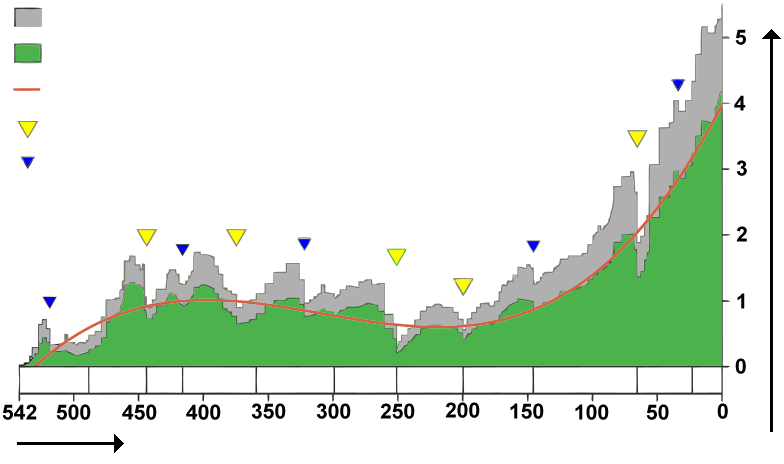Diversification Rates on:
[Wikipedia]
[Google]
[Amazon]
Diversification rates are the rates at which new species form (the

Speciation
Speciation is the evolutionary process by which populations evolve to become distinct species. The biologist Orator F. Cook coined the term in 1906 for cladogenesis, the splitting of lineages, as opposed to anagenesis, phyletic evolution within ...
rate, λ) and living species go extinct (the extinction
Extinction is the termination of a kind of organism or of a group of kinds (taxon), usually a species. The moment of extinction is generally considered to be the death of the last individual of the species, although the capacity to breed and ...
rate, μ). Diversification rates can be estimated from fossils
A fossil (from Classical Latin , ) is any preserved remains, impression, or trace of any once-living thing from a past geological age. Examples include bones, shells, exoskeletons, stone imprints of animals or microbes, objects preserved in ...
, data on the species diversity of clades
A clade (), also known as a monophyletic group or natural group, is a group of organisms that are monophyletic – that is, composed of a common ancestor and all its lineal descendants – on a phylogenetic tree. Rather than the English term, t ...
and their ages, or phylogenetic trees
A phylogenetic tree (also phylogeny or evolutionary tree Felsenstein J. (2004). ''Inferring Phylogenies'' Sinauer Associates: Sunderland, MA.) is a branching diagram or a tree showing the evolutionary relationships among various biological spec ...
. Diversification rates are typically reported on a per-lineage basis (e.g. speciation rate per lineage per unit of time), and refer to the diversification dynamics expected under a birth–death process.
A broad range of studies have demonstrated that diversification rates can vary tremendously both through time and across the tree of life. Current research efforts are focused on predicting diversification rates based on aspects of species or their environment. Diversification rates are also subject to various survivorship biases such as the " Push of the past"
Methods for estimating diversification rates
Fossil time series
Diversification rates can be estimated time-series data on fossil occurrences. With perfect data, this would be an easy task; one could just count the number of speciation and extinction events in a given time interval, and then use these data to calculate per-lineage rates of speciation and extinction per unit time. However, the incomplete nature of the fossil record means that our calculations need to include the possibility that some fossil lineages were not sampled, and that we do not have precise estimates for the times of speciation and extinction of the taxa that are sampled. More sophisticated methods account for the probability of sampling any lineage, which might also depend on some properties of the lineage itself (e.g. whether it has any hard body parts that tend to fossilize) as well as the environment in which it lives. Many estimates of diversification rates for fossil lineages are for higher-level taxonomic groups like genera or families. Such rates are informative about general patterns and trends of diversification through time and across clades but can be difficult to compare directly to rates of speciation and extinction of individual species.Clade age and diversity
Diversification rates can be estimated from data on the ages and diversities of monophyletic clades in the tree of life. For example, if a clade is 100 million years old and includes 1000 species, we can estimate the net diversification rate of that clade by using a formula derived from a birth-death model of diversification: Equations are also available for estimating speciation and extinction rates separately when one has ages and diversities for multiple clades.Phylogenetic trees
Diversification rates can be estimated using the information available in phylogenetic trees. To calculate diversification rates, such phylogenetic trees have to include branch lengths. Various methods are available to estimate speciation and extinction rates from phylogenetic trees using both maximum likelihood and Bayesian statistical approaches. One can also use phylogenetic trees to test for changing rates of speciation and/or extinction, both through time and across clades, and to associate rates of evolution with potential explanatory factors.Diversification rates through time and across clades

Predictors of diversification rates
References
* * {{cite journal , last= Sepkoski , first= J. John Jr. , year= 1979 , title= A kinetic model of Phanerozoic taxonomic diversity. II. Early Phanerozoic families and multiple equilibria. , journal= Paleobiology , volume= 5 , issue= 3 , pages= 222–251 , jstor= 2400257, doi = 10.1017/S0094837300006539 Phylogenetics Evolution